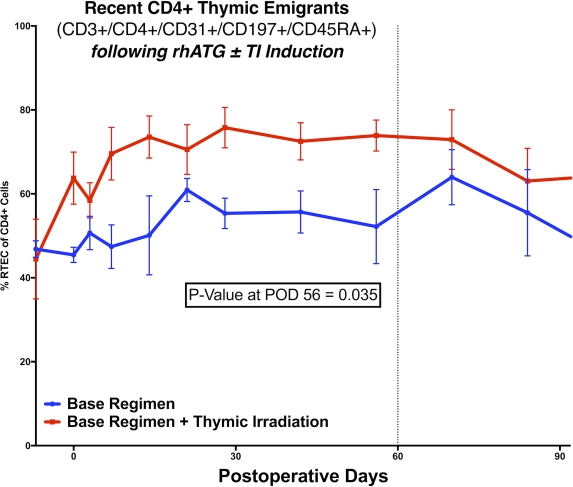Thymic Irradiation as a Maneuver for Repertoire Exchange in Costimulatory-Blockade-Based Immunotherapy
1Department of Surgery, Duke University, Durham, NC
2Department of Radiation Oncology, Duke University, Durham, NC.
Meeting: 2018 American Transplant Congress
Abstract number: B3
Keywords: Co-stimulation, Thymocytes, Thymus
Session Information
Session Name: Poster Session B: Acute and Chronic Graft Injury
Session Type: Poster Session
Date: Sunday, June 3, 2018
Session Time: 6:00pm-7:00pm
 Presentation Time: 6:00pm-7:00pm
Presentation Time: 6:00pm-7:00pm
Location: Hall 4EF
Background All successful, prospective clinical tolerance-induction strategies have employed thymic irradiation to achieve chimerism. However, evidence suggests durable chimerism is not required to attain tolerance. To examine the mechanism by which thymic irradiation (TI) may facilitate long-term allograft acceptance, we tested the hypothesis that addition of TI to costimulation-blockade (CoB) based immunotherapy would increase repertoire exchange, and specifically that depletion and repopulation stimulated by accelerated thymopoiesis would increase the fraction of the repertoire consisting of costimulation-sensitive cells and decrease rate of CoBRR in a preclinical model of renal transplant.
Methods Rhesus macaques (n=11) underwent bilateral nephrectomy followed by MHC mismatched renal transplant. Controls (n=6) received a base regimen of a single dose of steroid, Rhesus-specific anti-thymocyte globulin induction, and belatacept+sirolimus maintenance. Experimental animals (N=5) received base regimen with 7Gy TI on POD-3. Serial creatinine was used to monitor renal function.
Results Addition of TI to the base regimen resulted in an increase of CD4+ recent thymic emigrant cells (RTEC, defined by CD3+CD4+CD31+CD197+CD45RA+). This population remained more frequent than controls through the 60 days (P=0.035). At 6 months, no animals in control nor experimental groups experienced CoBRR.
Conclusions Addition of TI to CoB-based immunotherapy results in a burst of thymopoiesis and increases RTEC export from the thymus. In the setting of depletional induction, TI alters homeostatic repopulation to promote a favorable host response. Longitudinal phenotypic analysis is ongoing to assess durability of the effect of TI and long-term graft survival. This maneuver may provide an opportunity for the provision of donor antigen to further enhance the specificity of cells emigrating from the recipient thymus, which may promote tolerance without reliance on mixed chimerism. 
CITATION INFORMATION: Mulvihill M., Ezekian B., Gao Q., Samy K., Davis R., Leopardi F., Giles W., Yin F-.F., Willett C., Collins B., Kirk A. Thymic Irradiation as a Maneuver for Repertoire Exchange in Costimulatory-Blockade-Based Immunotherapy Am J Transplant. 2017;17 (suppl 3).
To cite this abstract in AMA style:
Mulvihill M, Ezekian B, Gao Q, Samy K, Davis R, Leopardi F, Giles W, Yin F-F, Willett C, Collins B, Kirk A. Thymic Irradiation as a Maneuver for Repertoire Exchange in Costimulatory-Blockade-Based Immunotherapy [abstract]. https://atcmeetingabstracts.com/abstract/thymic-irradiation-as-a-maneuver-for-repertoire-exchange-in-costimulatory-blockade-based-immunotherapy/. Accessed December 26, 2025.« Back to 2018 American Transplant Congress
